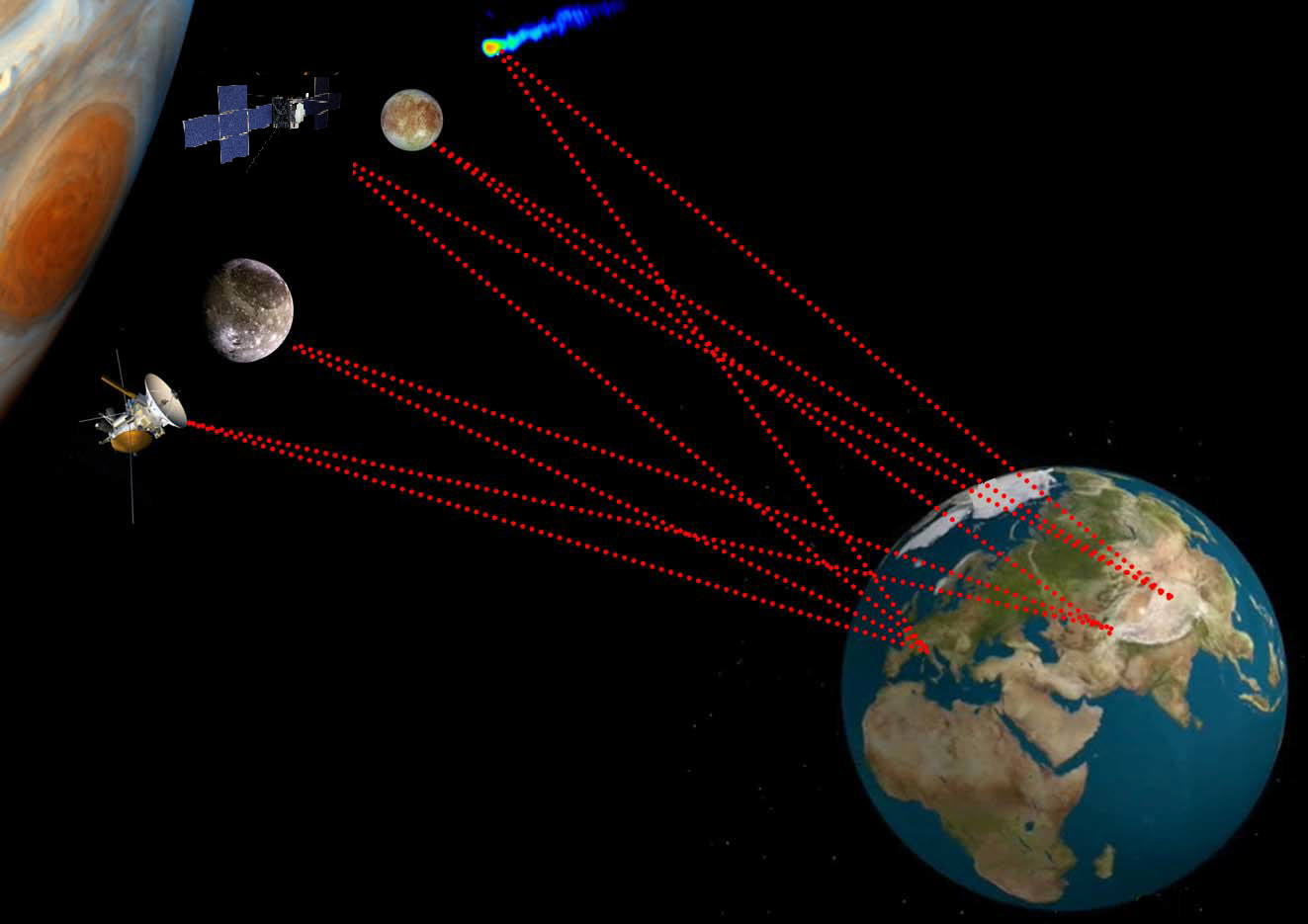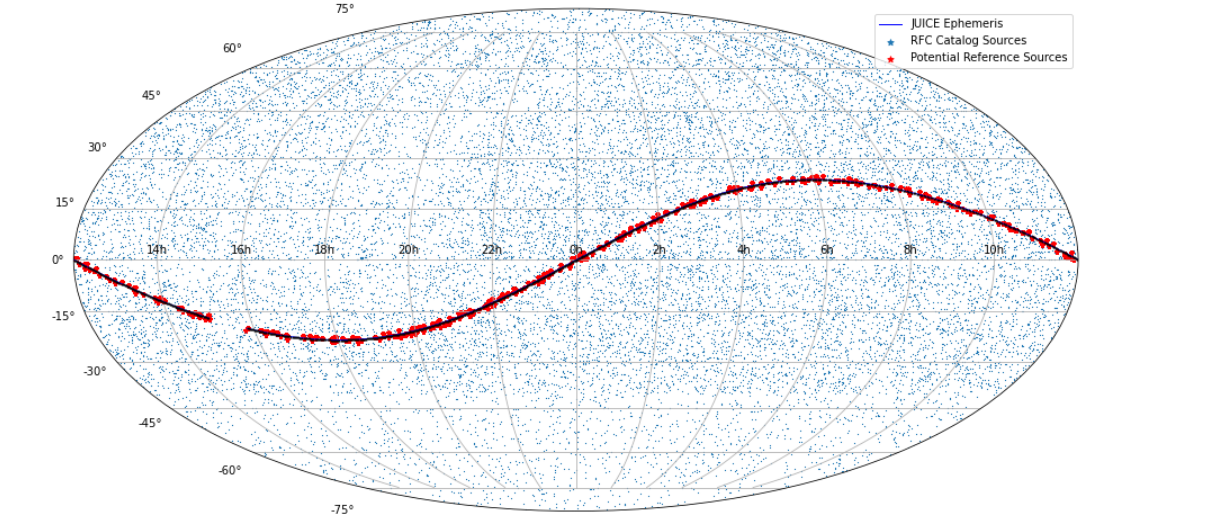Planetary Radio Interferometry and Doppler Experiment (PRIDE) with the JUICE mission as a case study
- 1Delft University of Technology, TU Delft, Delft University of Technology, Space Engineering, Delft, Netherlands (v.pallichadath@tudelft.nl)
- 2Joint Institute for VLBI ERIC, The Netherlands
- 3Observatoire de Paris, France
- 4University of Tasmania, Hobart, Australia
The Planetary Radio Interferometry and Doppler Experiment (PRIDE) technique utilize signal recording and processing technology developed originally for Very Long Baseline Interferometry (VLBI) to determine spacecraft lateral position in ICRF, as an extension of conventional radio-tracking techniques [1]. The essence of the PRIDE technique is in observing the spacecraft radio signal with a network of Earth-based radio telescopes. The PRIDE technique, developed at the Joint Institute for VLBI ERIC (JIVE), has been used for numerous experiments with several ESA planetary science missions. PRIDE has been selected by ESA as one of the eleven science experiments of the Jupiter Icy Moons Explorer (JUICE), the L-class mission scheduled for launch in 2023.

Figure 1: PRIDE Experiment for the JUICE Mission
The main observables of PRIDE are ultra-precise estimates of spacecraft lateral position based on the phase referenced VLBI tracking and radial Doppler measurements [3,7,8]. The methodology of PRIDE has been proven and validated with the ESA's Venus Express & Mars Express [1,2,4,7,8,9]. PRIDE will contribute to the determination of the JUICE spacecraft state vector and the improvement of the Galilean satellite ephemerides [4,5,10]. It is worth noticing the synergistic nature of PRIDE measurements to other key experiments of the JUICE mission, in particular addressing the major science goals of the mission.

Figure 2: PRIDE Experiment Planning chart during the cruise phase of the JUICE Mission. Blue dots indicate celestial positions of radio sources with well-defined coordinates suitable for phase-referencing VLBI [reference on the Petrov's online catalogue]. Red dots show those potential reference sources located within 1 degree to the celestial track of the JUICE spacecraft.
The paper will describe the analysis and implementation of system engineering methodologies of the PRIDE inputs into the operational design of the JUICE mission. A particular emphasis will be given on cross instrumental analysis and consolidation of top synergies of PRIDE with other JUICE experiments using the ESA science planning tools. The paper will demonstrate advanced methods of efficient experiment planning and block scheduling. The identification of celestial areas of interest in near-field VLBI (PRIDE) observations of interplanetary spacecraft on all phases of their missions, especially during the cruise phase will also be covered in this paper.
References
1) D. A. Duev. et al.: Spacecraft VLBI and Doppler tracking: algorithms and implementation, Astronomy & Astrophysics, 541, A43, 2012
2) G. Molera Calves. et al.: Observations and analysis of phase scintillation of spacecraft signal on the interplanetary plasma". In: A&A 564, A4, 2014
3) D. A. Duev. et al.: Planetary Radio Interferometry and Doppler Experiment (PRIDE) technique: A test case of the Mars Express Phobos fly-by, Astronomy & Astrophysics, Vol. 593, 2016
4) Dirkx D. et al.: Dynamical modeling of the Galilean moons for the JUICE mission, Planetary and Space Science 134 (2016) 82–95
5) Dirkx D. et al.: On the contribution of PRIDE JUICE to Jovian system ephemerides, Planetary and Space Science, 14–27, 2017
6) G. Molera Calves. et al.: Analysis of an Interplanetary Coronal Mass Ejection by a Spacecraft Radio Signal: A Case Study, Space Weather, 15
7) T. M. Bocanegra-Bahamón. et al.: Planetary Radio Interferometry and Doppler Experiment (PRIDE) technique: A test case of the Mars Express Phobos Flyby II. Doppler tracking: Formulation of observed and computed values, and noise budget, Astronomy & Astrophysics, 609, A59, 2018
8) T. M. Bocanegra-Bahamón. et al.: Venus Express radio occultation observed by PRIDE, Astronomy & Astrophysics, 624, A59, 2019
9) G. Molera Calvés. Et a.: High spectral resolution multi-tone Spacecraft Doppler tracking software: Algorithms and implementations, Publications of the Astronomical Society of Australia (PASA), 2021
10) Fayolle et al., Decoupled and coupled moons’ ephemerides estimation strategies - Application to the JUICE mission, submitted to Planetary & Space Science, 2022
How to cite: Pallichadath, V., Cimò, G., Dirkx, D., Fayolle Chambe, M., I. Gurvits, L., Lainey, V., Molera Calvés, G., Masdiana Md Said, N., and Vermeersen, B.: Planetary Radio Interferometry and Doppler Experiment (PRIDE) with the JUICE mission as a case study, Europlanet Science Congress 2022, Granada, Spain, 18–23 Sep 2022, EPSC2022-342, https://doi.org/10.5194/epsc2022-342, 2022.

